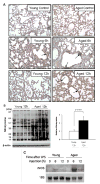The effects of aging on pulmonary oxidative damage, protein nitration, and extracellular superoxide dismutase down-regulation during systemic inflammation
- PMID: 21092756
- PMCID: PMC3340560
- DOI: 10.1016/j.freeradbiomed.2010.11.013
The effects of aging on pulmonary oxidative damage, protein nitration, and extracellular superoxide dismutase down-regulation during systemic inflammation
Abstract
Systemic inflammatory response syndrome (SIRS), a serious clinical condition characterized by whole-body inflammation, is particularly threatening for elderly patients, who suffer much higher mortality rates than the young. A major pathological consequence of SIRS is acute lung injury caused by neutrophil-mediated oxidative damage. Previously, we reported an increase in protein tyrosine nitration (a marker of oxidative/nitrosative damage) and a decrease in the antioxidant enzyme extracellular superoxide dismutase (EC-SOD) in the lungs of young mice during endotoxemia-induced SIRS. Here we demonstrate that during endotoxemia, down-regulation of EC-SOD is significantly more profound and prolonged, whereas up-regulation of iNOS is augmented, in aged compared to young mice. Aged mice also showed 2.5-fold higher protein nitration levels, compared to young mice, with particularly strong nitration in the pulmonary vascular endothelium during SIRS. Additionally, by two-dimensional gel electrophoresis, Western blotting, and mass spectrometry, we identified proteins that show increased tyrosine nitration in age- and SIRS-dependent manners; these proteins (profilin-1, transgelin-2, LASP 1, tropomyosin, and myosin) include components of the actin cytoskeleton responsible for maintaining pulmonary vascular permeability. Reduced EC-SOD in combination with increased oxidative/nitrosative damage and altered cytoskeletal protein function due to tyrosine nitration may contribute to augmented lung injury in the aged with SIRS.
Copyright © 2010 Elsevier Inc. All rights reserved.
Figures




Similar articles
-
Decreased pulmonary extracellular superoxide dismutase during systemic inflammation.Free Radic Biol Med. 2008 Sep 15;45(6):897-904. doi: 10.1016/j.freeradbiomed.2008.06.016. Epub 2008 Jun 24. Free Radic Biol Med. 2008. PMID: 18640266 Free PMC article.
-
Neuronal NOS-mediated nitration and inactivation of manganese superoxide dismutase in brain after experimental and human brain injury.J Neurochem. 2007 Apr;101(1):168-81. doi: 10.1111/j.1471-4159.2006.04353.x. J Neurochem. 2007. PMID: 17394464
-
Interaction among nitric oxide, reactive oxygen species, and antioxidants during endotoxemia-related acute renal failure.Am J Physiol Renal Physiol. 2003 Mar;284(3):F532-7. doi: 10.1152/ajprenal.00323.2002. Am J Physiol Renal Physiol. 2003. PMID: 12556364
-
Expression of extracellular SOD and iNOS in macrophages and smooth muscle cells in human and rabbit atherosclerotic lesions: colocalization with epitopes characteristic of oxidized LDL and peroxynitrite-modified proteins.Arterioscler Thromb Vasc Biol. 1998 Feb;18(2):157-67. doi: 10.1161/01.atv.18.2.157. Arterioscler Thromb Vasc Biol. 1998. PMID: 9484979 Review.
-
Protein tyrosine nitration--an update.Arch Biochem Biophys. 2009 Apr 15;484(2):117-21. doi: 10.1016/j.abb.2008.10.034. Epub 2008 Oct 30. Arch Biochem Biophys. 2009. PMID: 19007743 Review.
Cited by
-
Superoxide dismutase 3 controls adaptive immune responses and contributes to the inhibition of ovalbumin-induced allergic airway inflammation in mice.Antioxid Redox Signal. 2012 Nov 15;17(10):1376-92. doi: 10.1089/ars.2012.4572. Epub 2012 Jun 29. Antioxid Redox Signal. 2012. PMID: 22583151 Free PMC article.
-
Mechanisms of dysfunction in senescent pulmonary endothelium.J Gerontol A Biol Sci Med Sci. 2012 Mar;67(3):236-41. doi: 10.1093/gerona/glr248. Epub 2012 Mar 5. J Gerontol A Biol Sci Med Sci. 2012. PMID: 22396472 Free PMC article. Review.
-
Elevated truncated oxidized phospholipids as a factor exacerbating ALI in the aging lungs.FASEB J. 2019 Mar;33(3):3887-3900. doi: 10.1096/fj.201800981R. Epub 2018 Dec 6. FASEB J. 2019. PMID: 30521374 Free PMC article.
-
Voluntary running exercise protects against sepsis-induced early inflammatory and pro-coagulant responses in aged mice.Crit Care. 2017 Aug 8;21(1):210. doi: 10.1186/s13054-017-1783-1. Crit Care. 2017. PMID: 28789683 Free PMC article.
-
Protein Posttranslational Modifications: Roles in Aging and Age-Related Disease.Oxid Med Cell Longev. 2017;2017:5716409. doi: 10.1155/2017/5716409. Epub 2017 Aug 15. Oxid Med Cell Longev. 2017. PMID: 28894508 Free PMC article. Review.
References
-
- Cavaillon JM, Adrie C. Sepsis and non-infectious systemic inflammation : from biology to critical care. Weinheim: Wiley-VCH; 2009. Chichester : John Wiley[distributor]
-
- Levy MM, Fink MP, Marshall JC, Abraham E, Angus D, Cook D, Cohen J, Opal SM, Vincent JL, Ramsay G. 2001 SCCM/ESICM/ACCP/ATS/SIS International Sepsis Definitions Conference. Crit Care Med. 2003;31:1250–1256. - PubMed
-
- Bone RC, Balk RA, Cerra FB, Dellinger RP, Fein AM, Knaus WA, Schein RM, Sibbald WJ. Definitions for sepsis and organ failure and guidelines for the use of innovative therapies in sepsis. The ACCP/SCCM Consensus Conference Committee. American College of Chest Physicians/Society of Critical Care Medicine. Chest. 1992;101:1644–1655. - PubMed
-
- Astiz ME, Rackow EC. Septic shock. Lancet. 1998;351:1501–1505. - PubMed
-
- Stengle J, Dries D. Sepsis in the elderly. Crit Care Nurs Clin North Am. 1994;6:421–427. - PubMed
Publication types
MeSH terms
Substances
Grants and funding
LinkOut - more resources
Full Text Sources
Medical
Molecular Biology Databases

